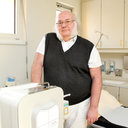Spontaneous osteonecrosis of the knee: biochemical markers of bone turnover and pathohistology.
Słowa kluczowe
Abstrakcyjny
OBJECTIVE
The aim of this study was to evaluate bone metabolism in patients with spontaneous osteonecrosis (ON) of the medial femoral condyle.
METHODS
In 22 consecutive patients, undergoing total knee arthroplasty, biochemical markers of bone metabolism were measured in aspirates from cancellous bone and in samples obtained simultaneously from peripheral blood. Specimens of the medial femoral condyle were available for histologic examination and the lesion size, assessed on radiographs, was compared with the results from bone turnover measurements. Twenty patients with osteoarthritis (OA) of the knee served as a control. Bone-specific alkaline phosphatase (bone ALP), osteocalcin (OC), procollagen type I N-terminal propeptide (PINP), and C-terminal cross-linking telopeptide (ICTP) were studied.
RESULTS
Mean serum levels of analytes were not different in patients with ON and OA. The serum concentrations averaged 16.2 vs 13.3 ng/mL (OC), 10.2 vs 12.1 ng/mL (bone ALP), 4.6 vs 4.1 ng/mL (ICTP), and 33.2 vs 40.4 ng/mL (PINP) in patients with ON and OA, respectively. In samples obtained from cancellous bone, mean concentrations of all markers were elevated significantly when compared to serum levels. The mean marker concentrations in samples obtained from cancellous bone were 33.8 vs 43.3 ng/mL (OC), 34.6 vs 37.3 ng/mL (bone ALP), 64.8 vs 36.1 ng/mL (ICTP, P=0.02), and 208.0 vs 176.2 ng/mL (PINP) in patients with ON and OA, respectively. The lesion size was at mean 440.5+/-275.8mm(2) in knees with ON and did not correlate with either serum or bone concentrations of all markers tested (P>0.1).
CONCLUSIONS
The marked elevation of markers in samples obtained from cancellous bone pointed at increased turnover in both diseases when compared to healthy individuals. In line with histologic findings of necrosis of subchondral bone, focal degradation of collagen type I was more pronounced in knees with ON. Mean serum concentrations of all markers, however, were not different from healthy individuals and thus did not provide any useful clue in the diagnosis spontaneous ON.


